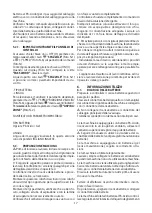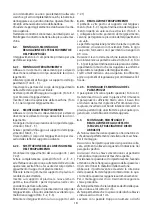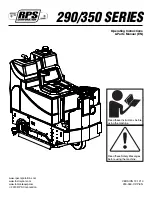
30
now possible to move the machine.
Once the machine have been moved, it is necessary
to carry out the same procedure on the contrary in
order to replace the lever in the machine working po-
sition ( Photo L - 1 ).
•
WARNING: Before using the machine be sure
that the unblocking lever is in the machine work-
ing position ( Photo L - 1 ).
3.5.
LIFTING AND TRANSPORT: MACHINE,
BATTERY AND BATTERY CHARGER
•
Never use a forklift truck to lift the machine. There
are no places on the frame that can be used to lift the
machine directly.
Before preparing the packing and transporting the
machine:
- Empty the recovery tank and the detergent solution
tank.
- Disassemble the squeegee and the brushes or pad
drivers.
- Disconnect and remove the batteries.
Place the machine on the original pallet (or an equiva-
lent one that can bear the weight and is big enough
for the machine’s overall dimensions) using an in-
clined surface.
Solidly anchor the machine and the squeegee to the
pallet using metallic brackets or other elements that
can bear the weight of the parts.
Lift the pallet with the machine and load it on the
transport vehicle.
Secure the machine and the pallet using ropes con-
nected to the transport vehicle.
As an alternative, when using private transport vehi-
cles, use inclined ramps to push the machine without
the pallet, making sure to protect all parts and the
machine itself against violent impacts, humidity, vi-
brations and accidental movements during transport.
The battery boxes have holes where tools can be
hooked for handling.
•
To lift or insert the battery (into the machine com-
partment), use only suitable personnel and equip-
ment (cables, eyehooks, etc.) for the operation and
to bear the weight of the loads involved. When trans-
porting, take the same precautions and follow the
same instructions provided for the machine together
with those in the special manufacturer’s manual.
The battery charger can be transported on its sup-
ports, both vertically and horizontally. Take the same
precautions and follow the same instructions pro-
vided for the machine together with those in the spe-
cial manufacturer’s manual.
4.
TECHNICAL INFORMATIONS
4.1.
GENERAL DESCRIPTION
4.1.1. BATTERIES
Regardless of the type of construction, battery perfor-
mances are indicated with the term capacity, which
always refers to a discharge period. Another important
value is the number of possible discharges. The capac-
ity is expressed in amps per hour (Ah), while the dis-
charge period is generally indicated as 20 hours (C20
or 20h, or not expressly indicated) or 5 hours (C5 or
5h). The discharge/charge cycles indicate the number
of times that the battery can hold a charge under the
best conditions, i.e. they indicate the useful battery
service life complying with all the necessary measures.
Therefore, the capacity of a battery varies depending
on how fast it uses energy (current). That’s why there’s
such a variation in the capacity values expressed as
C5 or C20. These factors must be taken into account
when comparing products available on the market
with our own.
This machine can be equipped with two types of bat-
teries that differ in terms of their construction and
features.
- Pb-Acid battery with tubular armoured modules: the
electrolyte level in each element must be periodically
checked!
•
If one element is no longer covered by the acid
solution it will oxidise in 24 hours, thus permanently
affecting that element’s performance.
☞
Refer to the battery manual to avoid physical dam-
age and economic loss.
- Gel module battery: this type of battery is mainte-
nance free and does not require special environments
for recharging (since it does not emit any harmful
gases); therefore, it is highly recommended.
•
It should not be taken for granted that batteries
and battery chargers with the same technical fea-
tures as those we offer will produce the same results.
Only perfect compatibility between these elements
(Pb-Acid batteries, gel batteries and battery chargers)
will safeguard the performances, the service life, the
safety and the economic value invested.
4.1.2. BATTERY CHARGER
This type of high-frequency battery charger efficiently
charges batteries, extending their operating and service
life. In addition, because they can be configured, it is a
very versatile solution; the same battery charger can be
used for both Pb-Acid batteries and for gel batteries.
•
It should not be taken for granted that batteries
and battery chargers with the same technical fea-
tures as those we offer will produce the same results.
Only perfect compatibility between these elements
(Pb-Acid batteries, gel batteries and battery chargers)
will safeguard the performances, the service life, the
safety and the economic value invested.
Refer to the relevant manufacturer’s manual provided.
Summary of Contents for COMFORT XXS
Page 3: ...3 1 2 A B 1 5 4 2 7 4 5 6 9 8 3 3...
Page 4: ...4 C 1 1 D 3 4 2...
Page 5: ...5 3 3 2 1 4 6 7 6 7 1 2 5 E F 1...
Page 6: ...6 H 2 G 1 3 3 1 4 2...
Page 8: ...8 1 L 2 2 4 1 M 3...
Page 9: ...9 N O 1 2 2 3 6 7 5 4 0 8 1 7 2 2 2 9 4 3 0 4 H2O CHEM 1 2 1 1 1 0 1 3 1 7 2 5 1...
Page 92: ...92 1 1 1 1 2 2 10 1 3 1 4...
Page 93: ...93 1 5 2 2 1 4 35 C 10 50 C 30 95 2 10...
Page 94: ...94 2 2 96 3 3 1 3 2 3 3...
Page 95: ...95 3 4 L L 1 L 2 L 1 L 1 3 5 4 4 1 4 1 1 20 20 20 5 C5 5 C5 20...
Page 99: ...99 7 6 6 1 6 2 6 2 1 3 3 5 6 2 2 5 3 6 2 3 7 2 2 2 3...
Page 100: ...100 2 3 7 2 1 6 2 4 4 6 45 4 E 6 6 2 5 A 6 6 3 0 1 1 0 6 4 50 C D 1 6 5...
Page 101: ...101 6 6 6 7 6 7 1 6 7 2...
Page 102: ...102 6 7 3 2 6 7 4 7 8 3 2 6 7 5 7 4 7 5 7 4 7 5 7...
Page 103: ...103 7 1 50 7 2 7 3 7 4 7 5 7 6 7 7...
Page 104: ...104 7 8 7 9 8 8 1 N 7 8 2 8 2 1 X X X X X X X X X X X X X X X X X X...
Page 106: ...106 8 2 3 8 2 4 8 2 5 8 2 6 8 2 7 8 2 8 8 2 9 8 2 10 100 20 30...
Page 107: ...107 9 12 9 1 2013 56 EU 9 2 2012 19 EU...
Page 108: ...108 2012 19 EU...
Page 109: ...109 8 6 2 1 OFF O SPEED N 1 N 6 ON I N 7 N 1 N 6 SPEED N 2 SET CTM FASA LAVORPRO...
Page 110: ...110 7 3 12...
Page 111: ...111 6...
Page 112: ...112 5 2 10...
Page 113: ...113 4 4 35 10 50 30 95...
Page 114: ...114 3 5 1 CE CE 2 1 2...
Page 115: ...115 2 3 1 CE 4 1...
Page 116: ...116 1 1 1 1 1 2...
Page 228: ...cod 7 504 0228 rev 14 02 2022...














































